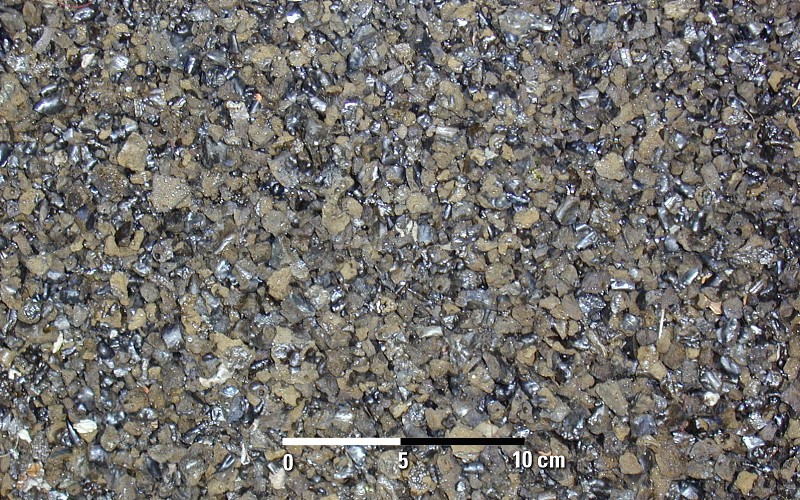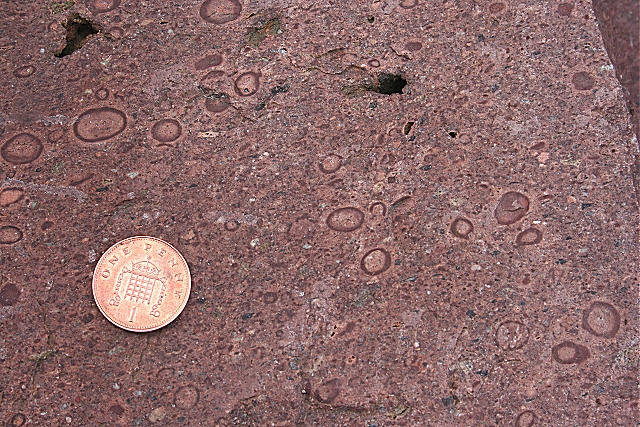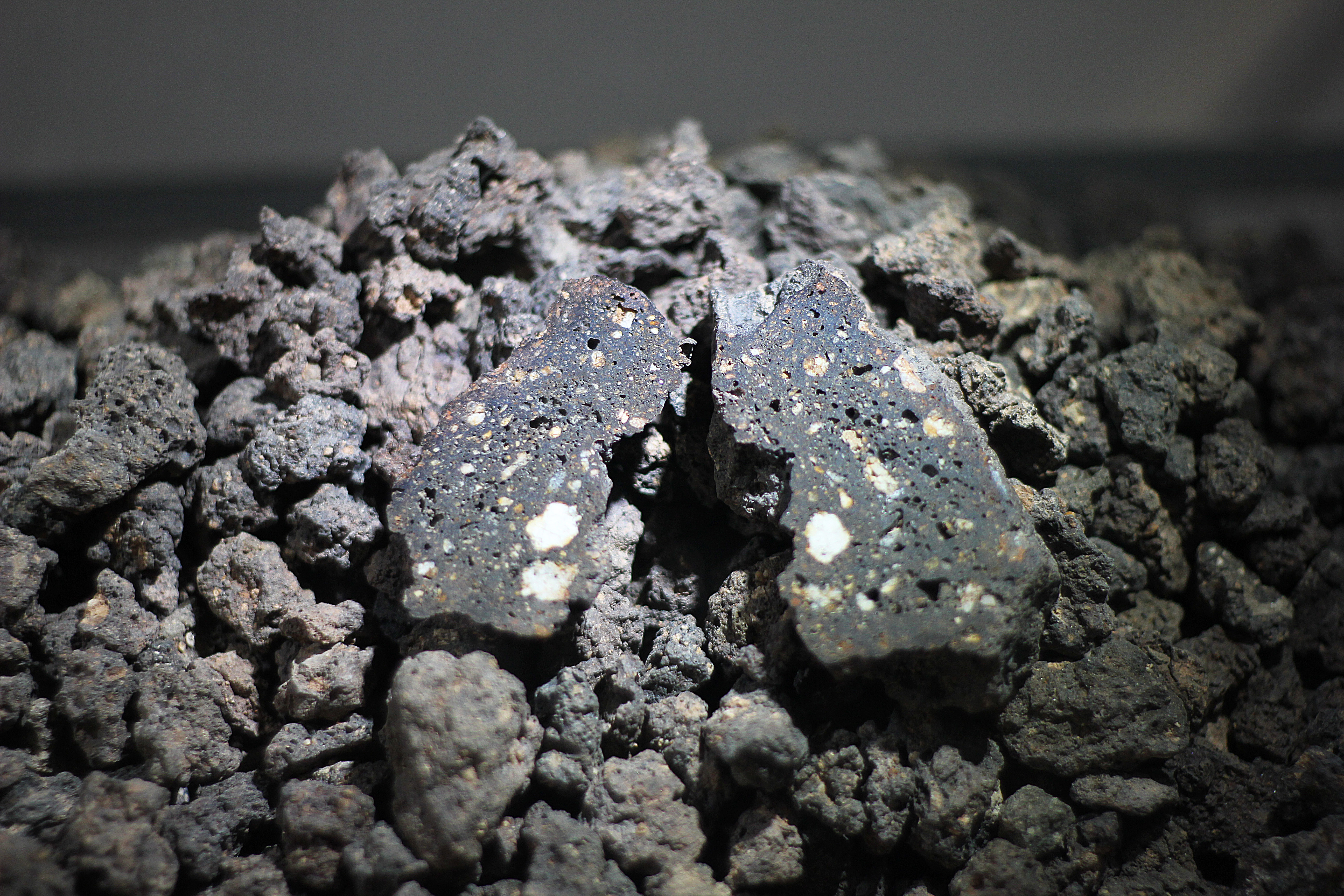|
Stac Fada Member
The Stac Fada Member is a distinctive layer towards the top of the Mesoproterozoic Bay of Stoer Formation, part of the Stoer Group (lowermost Torridonian Supergroup) in northwest Scotland. This rock unit is generally thick and is made of sandstone that contains accretionary lapilli and many dark green glassy fragments of mafic composition. Evidence for a meteorite impact in the area of the Minch or near Lairg has been published and refined in a series of studies from 2008 to 2019. The unit dates to approximately 1.2 billion years ago. The name comes from a small promontory to the west of the village of Stoer, in Assynt, Sutherland (at ). Extent The Stac Fada Member is exposed at a series of localities on or near the coast of Wester Ross, extending for about from the western side of Loch Ewe in the south to the Stoer peninsula in the north. Description The Stac Fada Member is an impactite consisting of a mixture of suevite and clast poor impact melt rocks. At the Stoer penins ... [...More Info...] [...Related Items...] OR: [Wikipedia] [Google] [Baidu] |
Accretionary Lapilli
Lapilli is a size classification of tephra, which is material that falls out of the air during a volcanic eruption or during some meteorite impacts. ''Lapilli'' (singular: ''lapillus'') is Latin for "little stones". By definition lapilli range from in diameter. A pyroclastic particle greater than 64 mm in diameter is known as a volcanic bomb when molten, or a volcanic block when solid. Pyroclastic material with particles less than 2 mm in diameter is referred to as volcanic ash. Formation Lapilli are spheroid-, teardrop-, dumbbell- or button-shaped droplets of molten or semi-molten lava ejected from a volcanic eruption that fall to earth while still at least partially molten. These granules are not accretionary, but instead the direct result of liquid rock cooling as it travels through the air. Lapilli tuffs are a very common form of volcanic rock typical of rhyolite, andesite and dacite pyroclastic eruptions, where thick layers of lapilli can be deposited during ... [...More Info...] [...Related Items...] OR: [Wikipedia] [Google] [Baidu] |
The Minch
The Minch ( gd, An Cuan Sgitheanach, ', ', '), also called North Minch, is a strait in north-west Scotland, separating the north-west Scottish Highlands, Highlands and the northern Inner Hebrides from Lewis and Harris in the Outer Hebrides. It was known as ("Scotland's fjord/firth") in Old Norse. The Lower Minch (), also known as the Little Minch, is the Minch's southern extension, separating Skye from the lower Outer Hebrides: North Uist, Benbecula, South Uist, Barra etc. It opens into the Sea of the Hebrides. The Little Minch is the northern limit of the Sea of the Hebrides. Geography The Minch and Lower Minch form part of the Inner Seas off the West Coast of Scotland, as defined by the International Hydrographic Organization. The Minch ranges from wide and is approximately long. It is believed to be the site of the Ullapool bolide impact, biggest meteorite ever to hit the British Isles. The Lower Minch is about wide. In June 2010 Eilidh Macdonald became the first person ... [...More Info...] [...Related Items...] OR: [Wikipedia] [Google] [Baidu] |
Conglomerate (geology)
Conglomerate () is a clastic sedimentary rock that is composed of a substantial fraction of rounded to subangular gravel-size clasts. A conglomerate typically contains a matrix of finer-grained sediments, such as sand, silt, or clay, which fills the interstices between the clasts. The clasts and matrix are typically cemented by calcium carbonate, iron oxide, silica, or hardened clay. Conglomerates form by the consolidation and lithification of gravel. They can be found in sedimentary rock sequences of all ages but probably make up less than 1 percent by weight of all sedimentary rocks. In terms of origin and depositional mechanisms, they are closely related to sandstones and exhibit many of the same types of sedimentary structures, e.g., tabular and trough cross-bedding and graded bedding.Boggs, S. (2006) ''Principles of Sedimentology and Stratigraphy.'', 2nd ed. Prentice Hall, New York. 662 pp. Friedman, G.M. (2003) ''Classification of sediments and sedimentary rocks.'' In G ... [...More Info...] [...Related Items...] OR: [Wikipedia] [Google] [Baidu] |
Geochemistry
Geochemistry is the science that uses the tools and principles of chemistry to explain the mechanisms behind major geological systems such as the Earth's crust and its oceans. The realm of geochemistry extends beyond the Earth, encompassing the entire Solar System, and has made important contributions to the understanding of a number of processes including mantle convection, the formation of planets and the origins of granite and basalt. It is an integrated field of chemistry and geology. History The term ''geochemistry'' was first used by the Swiss-German chemist Christian Friedrich Schönbein in 1838: "a comparative geochemistry ought to be launched, before geognosy can become geology, and before the mystery of the genesis of our planets and their inorganic matter may be revealed." However, for the rest of the century the more common term was "chemical geology", and there was little contact between geologists and chemists. Geochemistry emerged as a separate discipline after ... [...More Info...] [...Related Items...] OR: [Wikipedia] [Google] [Baidu] |
Terrane
In geology, a terrane (; in full, a tectonostratigraphic terrane) is a crust fragment formed on a tectonic plate (or broken off from it) and accreted or " sutured" to crust lying on another plate. The crustal block or fragment preserves its own distinctive geologic history, which is different from that of the surrounding areas—hence the term "exotic" terrane. The suture zone between a terrane and the crust it attaches to is usually identifiable as a fault. A sedimentary deposit that buries the contact of the terrane with adjacent rock is called an overlap formation. An igneous intrusion that has intruded and obscured the contact of a terrane with adjacent rock is called a stitching pluton. Older usage of ''terrane'' simply described a series of related rock formations or an area having a preponderance of a particular rock or rock groups. Overview A tectonostratigraphic terrane is not necessarily an independent microplate in origin, since it may not contain the full thickness ... [...More Info...] [...Related Items...] OR: [Wikipedia] [Google] [Baidu] |
Lewisian Complex
The Lewisian complex or Lewisian gneiss is a suite of Precambrian metamorphic rocks that outcrop in the northwestern part of Scotland, forming part of the Hebridean Terrane and the North Atlantic Craton. These rocks are of Archaean and Paleoproterozoic age, ranging from 3.0–1.7 billion years ( Ga). They form the basement on which the Torridonian and Moine Supergroup sediments were deposited. The Lewisian consists mainly of granitic gneisses with a minor amount of supracrustal rocks. Rocks of the Lewisian complex were caught up in the Caledonian orogeny, appearing in the hanging walls of many of the thrust faults formed during the late stages of this tectonic event. Distribution The main outcrops of the Lewisian complex are on the islands of the Outer Hebrides, including Lewis, from which the complex takes its name. It is also exposed on several islands of the Inner Hebrides, small islands north of the Scottish mainland and forms a coastal strip on the mainland from near L ... [...More Info...] [...Related Items...] OR: [Wikipedia] [Google] [Baidu] |
Loch Maree Fault
''Loch'' () is the Scottish Gaelic, Scots and Irish word for a lake or sea inlet. It is cognate with the Manx lough, Cornish logh, and one of the Welsh words for lake, llwch. In English English and Hiberno-English, the anglicised spelling lough is commonly found in place names; in Lowland Scots and Scottish English, the spelling "loch" is always used. Many loughs are connected to stories of lake-bursts, signifying their mythical origin. Sea-inlet lochs are often called sea lochs or sea loughs. Some such bodies of water could also be called firths, fjords, estuaries, straits or bays. Background This name for a body of water is Insular CelticThe current form has currency in the following languages: Scottish Gaelic, Irish, Manx, and has been borrowed into Lowland Scots, Scottish English, Irish English and Standard English. in origin and is applied to most lakes in Scotland and to many sea inlets in the west and north of Scotland. The word comes from Proto-Indo-European ... [...More Info...] [...Related Items...] OR: [Wikipedia] [Google] [Baidu] |
Accretionary Lapilli
Lapilli is a size classification of tephra, which is material that falls out of the air during a volcanic eruption or during some meteorite impacts. ''Lapilli'' (singular: ''lapillus'') is Latin for "little stones". By definition lapilli range from in diameter. A pyroclastic particle greater than 64 mm in diameter is known as a volcanic bomb when molten, or a volcanic block when solid. Pyroclastic material with particles less than 2 mm in diameter is referred to as volcanic ash. Formation Lapilli are spheroid-, teardrop-, dumbbell- or button-shaped droplets of molten or semi-molten lava ejected from a volcanic eruption that fall to earth while still at least partially molten. These granules are not accretionary, but instead the direct result of liquid rock cooling as it travels through the air. Lapilli tuffs are a very common form of volcanic rock typical of rhyolite, andesite and dacite pyroclastic eruptions, where thick layers of lapilli can be deposited during ... [...More Info...] [...Related Items...] OR: [Wikipedia] [Google] [Baidu] |
Suevite
Suevite is a rock consisting partly of melted material, typically forming a breccia containing glass and crystal or lithic fragments, formed during an impact event. It forms part of a group of rock types and structures that are known as impactites. Name The word "suevite" is derived from "Suevia", Latin name of Swabia. It was suggested by Adolf Sauer in 1901. Formation Suevite is thought to form in and around impact craters by the sintering of molten fragments together with unmelted clasts of the country rock. Rocks formed from more completely melted material found in the crater floor are known as '' tagamites''. Suevite is distinct from the pseudotachylite in an impact structure as the latter is thought to have formed by frictional effects within the crater floor and below the crater during the initial compression phase of the impact and the subsequent formation of the central uplift. Occurrence Suevite is one of the diagnostic rock-types for large impact structures. It ... [...More Info...] [...Related Items...] OR: [Wikipedia] [Google] [Baidu] |
Impactite
Impactite is rock created or modified by one or more impacts of a meteorite. Impactites are considered metamorphic rock, because their source materials were modified by the heat and pressure of the impact. On Earth, impactites consist primarily of modified terrestrial material, sometimes with pieces of the original meteorite. Creation When a large meteorite hits a planet, it can radically deform the rocks and regolith that it hits. The heat, pressure, and shock of the impact changes these materials into impactite. Only very massive impacts generate the heat and pressure needed to transform a rock, so impactites are created rarely. Characteristics Impactite includes shock-metamorphosed target rocks, melts (suevites) and mixtures of the two, as well as sedimentary rocks with significant impact-derived components (shocked mineral grains, tektites, anomalous geochemical signatures, etc.). In June 2015, NASA reported that impact glass has been detected on the planet Mars. Such mater ... [...More Info...] [...Related Items...] OR: [Wikipedia] [Google] [Baidu] |
Loch Ewe
Loch Ewe ( gd, Loch Iùbh) is a sea loch in the region of Wester Ross in the Northwest Highlands of Scotland. The shores are inhabited by a traditionally Gàidhlig-speaking people living in or sustained by crofting villages, the most notable of which, situated on the north-eastern shore, is the Aultbea settlement. History Due to the rugged and inaccessible terrain in which it is located, Loch Ewe has always been an assembly point for maritime trade. Around 1610 the area at the head of Loch Ewe, today known as Poolewe, was urbanised around an iron furnace using charcoal produced in the surrounding woodlands for fuel. English ironmasters found it more economic to ship the ore to Poolewe for smelting than to ship the processed charcoal to England to run furnaces there. The crofting villages which were established in the 1840s, as a result of the local parish's estate being reformed from run-rig to fixed holdings properties, were always quite small. Bualnaliub, nine miles (f ... [...More Info...] [...Related Items...] OR: [Wikipedia] [Google] [Baidu] |
Wester Ross
Wester Ross () is an area of the Northwest Highlands of Scotland in the council area of Highland. The area is loosely defined, and has never been used as a formal administrative region in its own right, but is generally regarded as lying to the west of the main watershed of Ross (the eastern part of Ross being Easter Ross), thus forming the western half of the county of Ross and Cromarty. The southwesternmost part of Ross and Cromarty, Lochalsh, is not considered part of Wester Ross by the local tourist organisation, ''Visit Wester Ross'', but is included within the definition used for the Wester Ross Biosphere Reserve.Wester Ross Biosphere Reserve Application. p. 2. Wester Ross has one of the lowest population densities in Europe, with just 1.6 people per km2, who live mostly in small crofting townships along the coastline of the region. The area is renowned for the scenic splendour of its mountains and coastline, and the range of wildlife that can be seen. It is a popular to ... [...More Info...] [...Related Items...] OR: [Wikipedia] [Google] [Baidu] |








